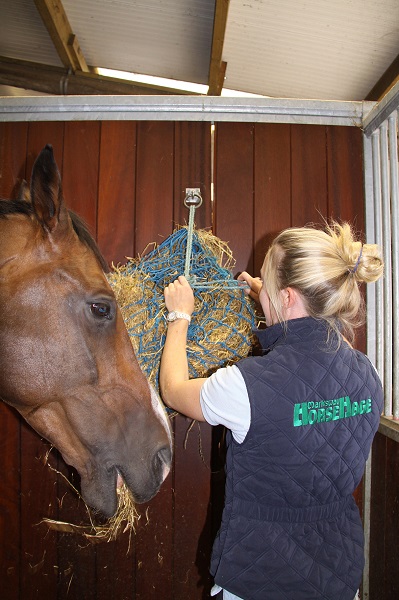Posted: 18th February 2020 | Back to news feed

Horse and pony owners are becoming far more aware now of the importance of forage in their animals’ diets. Recommendations are that up to 100% of the equine diet should be provided by forage.
The importance of fibre in the equine diet is because the horse’s highly developed large intestine has evolved to use bacterial fermentation to utilise high levels of fibre intake from many hours of grazing. Therefore low levels of fibre or poor quality fibre in the diet puts horses at serious risk of digestive problems.
Many horses are turned out during the day when weather permits, but may be brought into a stable at night. Most owners will feed the horse’s last bucket feed of the day and leave a good-sized net of forage for the horse to nibble on overnight and retire to bed happily, thinking of their animal snuggling down to rest on a warm bed of fresh straw or shavings.

In reality, because horses in the wild will graze for up to 18 hours a day, covering many miles in doing so, and are natural ‘trickle feeders’, by restricting their natural foraging habit by enclosing them in a stable overnight, they are more likely to consume their forage quickly, especially if it is fed from the floor or just a single net. This means they will then be left without sufficient fibre intake for several hours before being fed again in the morning and turned out again.
When we talk about grazing for up to 18 hours a day, this means within a 24 hour period rather than daylight hours, therefore it is very important that enough forage is provided to ensure that the horse is not left ‘fasting’ for more than four hours.
This can be achieved by using slow feeders or more than one hay net and double-netting to extend their natural foraging habit overnight as this is a highly motivated behaviour and will not interfere with the horse’s rest.
Being without forage for more than four hours at a time may also lead to your horse eating his bedding or developing other bad habits such as cribbing or weaving.
HorseHage offers two varieties of dust-free forage – High Fibre HorseHage and Timothy HorseHage - that are low in sugar, starch and energy and high in fibre and which can be safely fed to horses and ponies prone to laminitis. They are also ideal for horses and ponies that are good doers.
HorseHage requires no soaking and splits easily into wedges for easy netting or can be fed from a slow feeder.
For more information on forage and advice on feeding your horse, pony or donkey, please call the HorseHage Helpline on: 01803 527274 or visit www.horsehage.co.uk
The Equestrian Index newsfeed is compiled from articles submitted by advertising members and expresses the opinions of those members. Watsons Directories Ltd shall not be held liable for any inaccuracies or mis-statements therein.